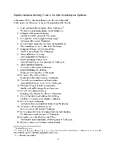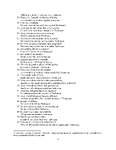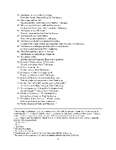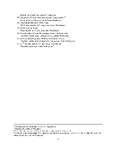Discourses of Muslim Scholars in Colonial Ghana
by John Hanson and Muhammad al-Munir Gibrill
Tunkuyau Epidemic (historical poem)
Creator: al-ḥājj 'Umar ibn Abī Bakri of Kete-Krachi
Description: This historical poem is composed by al-ḥājj ‘Umar Krachi (al-ḥājj ‘Umar ibn Abī Bakr) to describe and comment on an epidemic of an illness referenced as tunkuyau that afflicted the town of Krachi during the early twentieth century. The poem is available in Arabic and with an English translation.
This poem is one of the most studied works in al-ḥājj 'Umar Krachi’s corpus. Most scholars assume that it refers to the 1918 influenza epidemic in West Africa that killed as many as 100,000 Ghanaians (see K. David Patterson, "The Influenza Epidemic of 1918-1919 in the Gold Coast," Journal of African History, 24 (1983), 485-502). It is not certain, however, that this poem refers to influenza or the 1918 pandemic. The poem is not dated, for example, so one cannot assign it definitively with the 1918 outbreak. More significantly, al-ḥājj 'Umar does not refer to other communities suffering from the epidemic, as one would have expected. He also notes that no one died of the epidemic in Krachi. Finally, the term referring to the illness offers clues: in the Hausa language, the term mura refers to colds and the flu, and tunkuyau is used for several epidemics of gastric illnesses that occurred in the early twentieth century (see G.P. Bargery, A Hausa-English Dictionary and English-Hausa Vocabulary, online at: http://maguzawa.dyndns.ws/.
The poem opens in the prosodic style of the classic Arabic qaṣīda with a formulaic opening: qifū wa sma'ū an tunkuyau ("stop and hear this recitation about tunkuyau"). The poem follows with a detailed description of the symptoms of tunkuyau. The illness begins with a headache, coldness, dizziness, and palpitations; subsequent symptoms include severe fever, bitter taste, a rumbling stomach, vomiting, passing gas, and urination. These initial signs are followed by abnormal behaviors in its victims, such as groaning, whimpering, crying, scratching, salivating, restlessness, and a loss of sense of shame. Eventually those afflicted are filled with the dread of pending death, and many begin preparing for it. The poem notes that it affected everyone without discrimination of age, sex, or class, and that it responded to no cures. Notably, too, it did not kill anyone and did not linger long, except in a few cases. The poem concludes with a prayer to God and supplications through saints, prophets and especially the sacred sūras of the Qur’an for His succor.
Note that al-ḥājj 'Umar Krachi's poem references the classical Muslim belief in the four cardinal humors: blood, phlegm, choler (yellow bile), and melancholy (black bile). For example, see line 5: "It appears bilious, but is not of bile / And it is not phlegm, but tunkuyau." Many Muslim scholars draw on Islamic texts and diagnose ailments based on this system.
The poem treats tunkuyau as a serious communal health problem, but it includes some humorous elements. It is composed in one of the light meters of Arabic prosody: fa'ūlun, fa'ūlun, fa'ūlun, fa'ūlun/ fa'ūlun, fa'ūlun, fa'ūlun, fa'ūlun; called al-Mutaqārib. In addition, the poet employs imagery that contrast between the serious and the trivial. Note the reference to how tunkuyau afflicted old women, young ladies or learned-scholars, who would forget their litanies. The poem also draws on classical Arabic poetic imagery with its invocation of 'Antara, the Pre-Islamic Arab hero reputedly born to an Arab father and an African (black) mother.
This poem is one of the most studied works in al-ḥājj 'Umar Krachi’s corpus. Most scholars assume that it refers to the 1918 influenza epidemic in West Africa that killed as many as 100,000 Ghanaians (see K. David Patterson, "The Influenza Epidemic of 1918-1919 in the Gold Coast," Journal of African History, 24 (1983), 485-502). It is not certain, however, that this poem refers to influenza or the 1918 pandemic. The poem is not dated, for example, so one cannot assign it definitively with the 1918 outbreak. More significantly, al-ḥājj 'Umar does not refer to other communities suffering from the epidemic, as one would have expected. He also notes that no one died of the epidemic in Krachi. Finally, the term referring to the illness offers clues: in the Hausa language, the term mura refers to colds and the flu, and tunkuyau is used for several epidemics of gastric illnesses that occurred in the early twentieth century (see G.P. Bargery, A Hausa-English Dictionary and English-Hausa Vocabulary, online at: http://maguzawa.dyndns.ws/.
The poem opens in the prosodic style of the classic Arabic qaṣīda with a formulaic opening: qifū wa sma'ū an tunkuyau ("stop and hear this recitation about tunkuyau"). The poem follows with a detailed description of the symptoms of tunkuyau. The illness begins with a headache, coldness, dizziness, and palpitations; subsequent symptoms include severe fever, bitter taste, a rumbling stomach, vomiting, passing gas, and urination. These initial signs are followed by abnormal behaviors in its victims, such as groaning, whimpering, crying, scratching, salivating, restlessness, and a loss of sense of shame. Eventually those afflicted are filled with the dread of pending death, and many begin preparing for it. The poem notes that it affected everyone without discrimination of age, sex, or class, and that it responded to no cures. Notably, too, it did not kill anyone and did not linger long, except in a few cases. The poem concludes with a prayer to God and supplications through saints, prophets and especially the sacred sūras of the Qur’an for His succor.
Note that al-ḥājj 'Umar Krachi's poem references the classical Muslim belief in the four cardinal humors: blood, phlegm, choler (yellow bile), and melancholy (black bile). For example, see line 5: "It appears bilious, but is not of bile / And it is not phlegm, but tunkuyau." Many Muslim scholars draw on Islamic texts and diagnose ailments based on this system.
The poem treats tunkuyau as a serious communal health problem, but it includes some humorous elements. It is composed in one of the light meters of Arabic prosody: fa'ūlun, fa'ūlun, fa'ūlun, fa'ūlun/ fa'ūlun, fa'ūlun, fa'ūlun, fa'ūlun; called al-Mutaqārib. In addition, the poet employs imagery that contrast between the serious and the trivial. Note the reference to how tunkuyau afflicted old women, young ladies or learned-scholars, who would forget their litanies. The poem also draws on classical Arabic poetic imagery with its invocation of 'Antara, the Pre-Islamic Arab hero reputedly born to an Arab father and an African (black) mother.
Date: 1921
Date Range: 1920-1929
Location: Kete-Krachi, Volta Region, Ghana
Format: Text/pdf
Language: Arabic
Rights Management: Educational use only, no other permissions
Contributing Institution: Muhammad al-Munir Gibrill; John H. Hanson; Institute of African Studies, University of Ghana at Legon; Northwestern University; MATRIX: The Center for Humane Arts, Letters & Social Sciences Online at Michigan State University
Contributor: Muhammad al-Munir Gibrill (translator and transcriber); John H. Hanson (reviewer)
Archive: University of Ghana at Legon, Institute of African Studies
Source:
University of Ghana at Legon, Institute of African Studies, Arabic collection, document number 23. The collection holds other copies: documents numbers 131 and 305.







